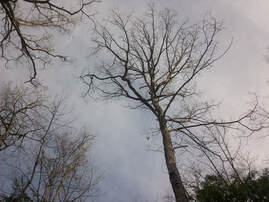CONSERVATION CORNER
A weekly blog for all things conservation
 Small Scale, Big Reward Forest Management Tools By: Adam Chorba, Forest Specialist Forestry is often viewed as only large-scale, long-term projects, and this is often true. Forestry is always about planning ahead and getting the most benefits out of an area. However, some concepts can be utilized to benefit small areas, from a few acres to even just a few trees, and it can be accomplished in a relatively short time. If these concepts are done properly, they can have great rewards for both nature and landowner. A Crop Tree Release is a silvicultural practice that can help increase the growth and production of desirable crop trees by selectively cutting less desirable trees that are competing with the crown of the selected crop tree. In a typical forest stand, the crowns, or tops of trees, are almost always in competition. This is normal. However, crown competition can lead to growth and crop production restrictions due to a lack of air circulation and photosynthetic processes. These conditions in the canopy can also increase the possibility of damage from insects and disease and reduce the ability of some species to achieve proper pollination.
Although crown competition is common in even some of the healthiest stands, removing that stress in some cases can help maximize your entire stand potential. The decrease in crown competition not only increases tree vigor but also allows for more seed and sunlight to reach the forest floor. This will increase the potential for desired tree regeneration and increase food and cover sources for wildlife at both canopy and ground level. Tree species selection truly falls on the landowner’s decision depending on their goals. However, trees that are most often selected are trees that can increase your forest in both monetary and ecological value. These are often species like Oak or Black Cherry, but many other species can be selected. For best results, be sure to choose trees that are already healthy and stable and will thrive in the selected site. If you’re looking to increase timber value, be sure to target trees that are moderate size, approximately 6-16 inches in diameter. Increasing canopy space for these trees may help the tree to increase in growth rate, increasing potential value and reducing the amount of time needed before harvest. If your forestry goals are geared more towards crop production, regeneration, and/or wildlife benefits then target larger diameter trees as your crop tree and release them. To properly release the crown of a crop tree, approach the trunk of your selected crop tree and look up into the crown. Take note of any trees that have a crown in direct competition on all sides, including under the crown. Those are the trees to be removed. The recommended minimum amount of canopy released is ½, but typically ¾ to full crown release is desired. Factors that often restrict full crown release may be, the inability to safely remove the tree, the competitor is that of another desired species, removal of the tree may severely damage the crop tree, and/or removing all competitive trees may allow excess light in. When releasing crop trees, try to not remove an excessive amount of trees. The extra light may trigger sucker or epicormic sprouting. Epicormic sprouting is the sprouting of branches along the trunk which can decrease timber value. Excess light in a stand also has the potential to invite unwanted competition on the ground level that may restrict any regeneration. Whenever working in the forest, especially when felling trees, be sure to have a full understanding of all the training and safety equipment needed and be sure to apply that knowledge. Due to such unpredictability in forest composition, it is always a good idea to contact a professional before doing any forest manipulation. This ensures that your goals are being met and best management practices are being implemented. In forestry, it could take a short time to create decades of issues. If this article interests you, keep an eye out for more “Small Scale, Big Reward Forest Management Tools” series in the future. Or if you’re looking for more information, contact your local conservation district. The Bradford County Conservation District is committed to helping people manage resources wisely. You can visit the Bradford County Conservation District at 200 Lake Rd in Wysox across from the Wysox Fire Hall. Contact us at (570) 485-3144 or visit our web page at www.bccdpa.com.
0 Comments
Leave a Reply. |
AuthorsVarious staff at the Bradford County Conservation District Archives
July 2024
Categories
All
|
|
Bradford County Conservation District
Stoll Natural Resource Center 200 Lake Road, Suite E | Towanda PA 18848 Phone: (570)-485-3144 |
